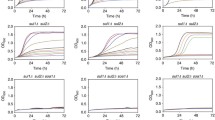Abstract
Thiocapsa floridana strain 1711, andChromatium strains 1611 and 6412 can grow with molecular hydrogen replacing sulfide as the electron donor. Sulfate suffices as the sulfur source. The incorporation of radioactive sulfur from35S-sulfate was measured in growing cells in which molecular hydrogen or acetate was the electron donor. In cells pre-grown in sulfide, the incorporation of radioactivity began slowly after a lag period; in contrast, cells grown in sulfate took up the marker at a faster rate and without a lag. The radioactivity appeared in protein as cysteine and methionine. No elimination of sulfide was detected during growth. Thus, the reduction of sulfate was purely assimilatory.
Similar content being viewed by others
References
Bandurski, R. S., Wilson, L. G. andSquires, C. L. 1956. The mechanism of “active sulfate” formation. J. Am. Chem. Soc.78: 6408–6409.
Dent, C. E. 1948, A study of the behavior of some sixty amino-acids and other ninhydrin-reacting substances on phenol-‘collidine’ filter-paper chromatograms, with notes as to the occurrence of some of them in biological fluids. Biochem. J.43: 169–180.
Gregory, J. D. andRobbins, P. W. 1960. Metabolism of sulfur compounds (Sulfate metabolism). Ann. Rev. Biochem.29: 347–364.
Hendley, D. D. 1955. Endogenous fermentation in Thiorhodaceae. J. Bacteriol.70: 625–634.
Hurlbert, R. E. andLascelles, J. 1963. Ribulose diphosphate carboxylase in Thiorhodaceae. J. Gen. Microbiol.33: 445–458.
Lippert, K. D. 1967. Die Verwertung von molekularom Wasserstoff durchChlorobium thiosulfatophilum. Thesis, Göttingen.
Lougheed, G. J. andMilazzo, F. H. 1965. A study of some aspects of sulfur metabolism in the wood-rotting basidiomycete,Fomes geotropus. Can. J. Microbiol.11: 959–966.
Pfennig, N. 1965. Anreicherungskulturen für rote und grüne Schwefelbakterien, p. 179–189 u. 503–504.In Anreicherungskultur und Mutantenauslese, Symposium in Göttingen, 1964. Zentr. Bakteriol. Parasitenk., I. Abt., Supplementheft 1, 1965.
Robbins, P. W. andLipmann, F. 1956. The enzymatic sequence in the biosynthesis of active sulfate. J. Am. Chem. Soc.78: 6409–6410.
Roelofsen, P. A. 1934. On the metabolism of the purple sulfur bacteria. Koninkl. Ned. Akad. Wetenschap. Proc.37: 660–669.
Schlegel, H. G. undLafferty, R. M. 1961. Radioaktivitätsmessung an Einzellern auf Membranfiltern. Arch. Microbiol.38: 52–54.
Schmidt, K., Liaaen Jensen, S. undSchlegel, H. G. 1963. Die Carotinoide der Thiorhodaceae. I. Okenon als Hauptcarotinoid vonChromatium okenli Perty. Arch. Mikrobiol.46: 117–126.
Schmidt, K., Pfennig, N. andLiaaen Jensen, S. 1965. Carotenoids of Thiorhodaceae. IV. The carotenoid composition of 25 pure isolates. Arch. Mikrobiol.52: 132–146.
Thiele, H. H. 1966. Wachstumsphysiologische Untersuchungen an Thiorhodaceae; Wasserstoff-Donatoren und Sulfatreduktion. Thesis, Göttingen.
Thiele, H. H. 1968a. Die Verwertung einfacher organischer Substrate durch Thiorhodaceae. Arch. Mikrobiol.60: 124–138.
Thiele, H. H. 1968b. Sulfur metabolism in Thiorhodaceae. V. Enzymes of sulfur metabolism inThiocapsa floridana andChromatium species. Antonie van Leeuwenhock34: 350–356.
Trüper, H. G. 1964a. CO2-Fixierung und Intermediarstoffwechsel beiChromatium okenii Perty. Arch. Mikrobiol.49: 23–50.
Trüper, H. G. 1964b. Sulphur metabolism in Thiorhodaceae. II. Stoichiometric relationship of CO2 fixation to oxidation of hydrogen sulphide and intracellular sulphur inChromatium okenii. Antonie van Leeuwenhoek30: 385–394.
Trüper, H. G. andPfennig, N. 1966. Sulphur metabolism in Thiorhodaceae. III. Storage and turnover of thiosulphate sulphur inThiocapsa floridana andChromatium species. Antonie van Leeuwenhoek32: 261–276.
Trüper, H. G. andSchlegel, H. G. 1964. Sulphur metabolism in Thiorhodaceae. I. Quantitative measurements on growing cells ofChromatium okenii. Antonie van Leeuwenhoek30: 225–238.
Wilson, L. G. 1962. Metabolism of sulfate: sulfate reduction. Ann. Rev. Plant Physiol.13: 201–224.
Wood, J. L. andMills, G. C. 1952. Preparation ofl-methionine-S23 andl-cysteine-S23 from radioactive yeast. J. Am. Chem. Soc.74: 2445.
Author information
Authors and Affiliations
Rights and permissions
About this article
Cite this article
Thiele, H.H. Sulfur metabolism in Thiorhodaceae. IV. Assimilatory reduction of sulfate byThiocapsa floridana andChromatium species. Antonie van Leeuwenhoek 34, 341–349 (1968). https://doi.org/10.1007/BF02046456
Received:
Published:
Issue Date:
DOI: https://doi.org/10.1007/BF02046456




